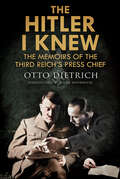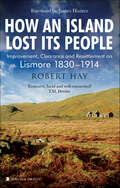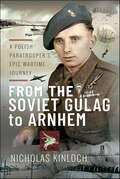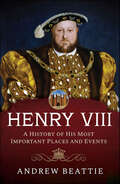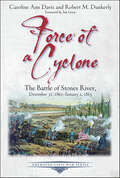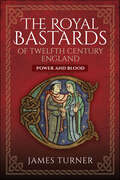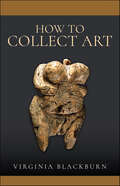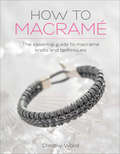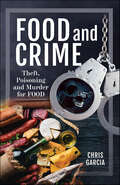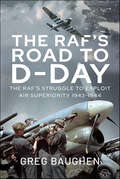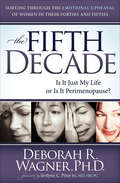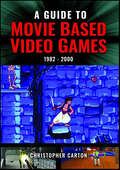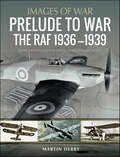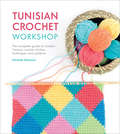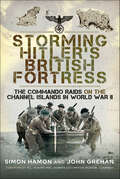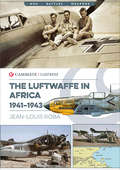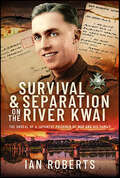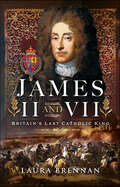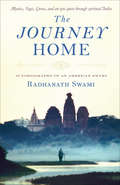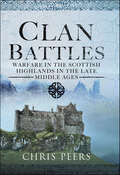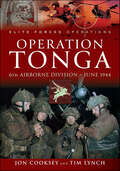- Table View
- List View
The Hitler I Knew: The Memoirs of the Third Reich's Press Chief
by Otto DietrichA biography of Hitler by his long-serving press chief and close associate. "Up to the last moment, his overwhelming, despotic authority aroused false hopes and deceived his people and his entourage. Only at the end, when I watched the inglorious collapse and the obstinacy of his final downfall, was I able suddenly to fit together the bits of mosaic I had been amassing for twelve years into a complete picture of his opaque and sphinx-like personality." - Otto Dietrich When Otto Dietrich was invited in 1933 to become Adolf Hitler's press chief, he accepted with the simple, uncritical conviction that Adolf Hitler was a great man, dedicated to promoting peace and the welfare for the German people. At the end of the war, imprisoned and disillusioned, Dietrich sat down to write what he had seen and heard in twelve years of the closest association with Hitler, requesting that it be published after his death. Dietrich's role placed him in a privileged position. He was hired by Hitler in 1933, and was a confidant until 1945, and he worked and clashed with Joseph Goebbels. His direct, personal experience of life at the heart in the Reich makes for compelling reading.
How an Island Lost Its People: Improvement, Clearance and Resettlement on Lismore 1830–1914
by Robert HayIn 1830, the little Hebridean island of Lismore was one of the granaries of the West Highlands, with every possible scrap of land producing bere barley or oats. The population had reached its peak of 1500, but by 1910, numbers had dwindled to 400 and were still falling. The agricultural economy had been almost completely transformed to support sheep and cattle, with ploughland replaced by the now familiar green grassy landscape. With reference to documentary sources, including Poor Law reports, the report of the Napier Commission into the condition crofters in the Highlands and Islands, as well as local documents and letters, this book documents a century of emigration, migration and clearance and paints an intimate portrait of the island community during a period of profound change. At the same time, it also celebrates the achievements of the many tenants who grasped the opportunities involved in agricultural improvement.
From the Soviet Gulag to Arnhem: A Polish Paratrooper's Epic Wartime Journey
by Nicholas KinlochAs featured on TV. The incredible true story of a teenage boy’s perilous journey around the world during World War Two. “A tale of determination and triumph” – Kay Burley, Sky News Stan was aged 15 when war broke out. Over a period of 5 years, he dodged death as he travelled thousands of kilometres from Poland to the UK, via Soviet gulags, Uzbekistan, the Middle East and India. He then trained as a paratrooper in Scotland. He met a local girl and was going to get married, but had to leave her behind when he was dropped into battle at Arnhem. He was trapped behind enemy lines and captured by the Nazis. Only the Dutch underground might be able to help him escape. This thrilling memoir is an inspiring and personal account of a triumph of resilience and courage against great odds.
Henry VIII: A History of his Most Important Places and Events
by Andrew BeattieThis book follows the life and legacy of the UK’s most famous monarch by exploring the places he built, lived in and traveled to. The story of Henry VIII is well known: he is famed throughout the world as the charismatic king of England who married six wives (and executed two of them), who broke with Rome and dissolved England’s monasteries, and who grew from a Renaissance prince into a lustful, egotistical and callous tyrant. He is the subject of scholarly and popular biographies and of numerous fictional works, from John Fletcher and William Shakespeare’s jointly authored play Henry VIII to contemporary novels, films and TV series. But this book tells the story of Henry VIII in a very different way to any of these: through the places where the events of his life unfolded. From Westminster Abbey and the Tower of London to the site of the Field of the Cloth of Gold near Calais where Henry met the French King Francis I for a week of pageantry in 1520, and from his lavish palaces in London to quieter manor houses in the English countryside which he visited during his annual summer “progress”, a whole new light is thrown on this most compelling of historical figures. While some sites associated with Henry are now very ruinous – such as Woking Palace in Surrey, which Henry remodeled into a lavish royal residence but which is now little more than a few tumbledown walls, or Greenwich Palace, where he was born, of which only a few remnants from his era remain – others, most famously Hampton Court, are much more substantial; the book looks at Henry’s connections with each site in turn, along with the conditions that today’s visitors to the site can expect, beginning with the Thames-side palaces from Greenwich upstream to Hampton Court, before broadening its scope to include properties and sites outside London, in the West and North of England and in Northern France.
Force of a Cyclone: The Battle of Stones River, December 31, 1862–January 2, 1863 (Emerging Civil War Series)
by Robert M. Dunkerly Caroline Ann DavisAuthors Caroline Davis and Bert Dunkerly explore a significant turning point of the Civil War—a battle that had the highest percentage of casualties on both sides. All of Middle Tennessee held its breath when the new year dawned in 1863. One day earlier on December 31, Braxton Bragg’s Confederate Army of Tennessee faced off against William Rosecrans’s Federal Army of the Cumberland just outside Murfreesboro along Stones River. The commanders, who led armies nearly equal in size, had prepared identical attack plans, but Bragg struck first. His morning attack bent the Federal line back upon itself. The desperate fighting seesawed throughout the day amid rocky outcroppings and cedar groves. The Federals managed to avoid a crushing defeat and hold on until dark as the last hours of the old year slipped away. The cold and exhausted soldiers rang in the New Year surrounded by the pitiful cries of the wounded punctuated by cracks of skirmish fire while the opposing generals contemplated their next moves. With the fate of Middle Tennessee yet to be determined, President Abraham Lincoln’s Emancipation Proclamation went into effect on January 1, 1863. The president had signed the proclamation back in September of 1862, but he needed battlefield victories to bolster its authority. The stakes being gambled outside Murfreesboro were enormous. Determined to win the battle outright, Bragg launched another large-scale assault on January 2. The fate of the Army of the Cumberland and the impact of the Emancipation Proclamation hung in the balance. In Force of a Cyclone: The Battle of Stones River, December 31, 1862–January 2, 1863, authors Caroline Davis and Bert Dunkerly explore a significant turning point of the Civil War, and one that had the highest percentage of casualties on both sides of any Civil War battle. Lincoln himself would often look back on that fragile New Year’s Day and ponder all that was at stake. “I can never forget whilst I remember anything,” he told Federal commander Maj. Gen. William S. Rosecrans, “that about the end of last year and the beginning of this, you gave us a hard-earned victory, which, had there been a defeat instead the nation could scarcely have lived over.”
The Royal Bastards of Twelfth Century England: Power and Blood
by James TurnerThe many storied monarchs of twelfth century England lived, fought, loved, and died surrounded by their illegitimate relatives. While their many contributions have too often been overlooked, these illegitimate sons, daughters and siblings occupied crucial positions within the edifice of royal authority, serving their legitimate relatives as proxies and lieutenants. In addition to occupying roles and offices at the center of royal administration, Anglo-Norman and Angevin royal bastards, exiled to the fringes of family identity by a twist of fate, provided the kings of England with military and political support from amidst the aristocratic affinities into which they were embedded. Rather than merely inert pieces on the dynastic game board or passive conduits of royal association, these men and women were engaged participants in contemporary politics, proactively cultivating and shaping the thrones’ relationship with its principal subjects. This book, the first full length study dedicated to the subject, examines the seminal conflicts and changing shape of the royal dynasty during a period of turbulent and formative development in the nature and institutions royal government through the rarely before accessed perspective of the reigning monarchs’ illegitimate family members and deputies. More than that this study aims, as far as possible, to illuminate and bring to life the lives, triumphs and tragedies of these fascinating half-forgotten personages. The victims of a rapid and profound demographic and social change which drastically recontextualized their position with royal family identity and aristocratic society, the bastards of the English royal family found new methods to survive and thrive.
How to Collect Art
by Virginia BlackburnA comprehensive and up-to-date guide to collecting across the board, from grand Old Masters to humble kitchenalia. People have always made art and people have always collected art. But it is only recently that collecting became possible for everyone, not just the very rich. Indeed, collecting has never been more popular, as the rise of art fairs, antique fairs, television programs devoted to finding treasures in your attic and much more attests. And not only is collecting fun, it could be potentially very profitable, too. But where to start? These days everything is collectable, from Old Masters to 1950s kitchenalia and it can be bewildering when you start out. And not just when you start out. Even experienced collectors need some help and guidance and How To Collect Art provides exactly this. Author and collecting expert Virginia Blackburn takes you through everything you need to know, tackling not only mainstream fields such as paintings, furniture, china and statuary, but through antiquities, modern sculpture, Sailors’ Valentines, street art, and much more. This is a comprehensive look at many and varied fields of collecting, for amateur and professional alike. Virginia also explains how to educate yourself in your chosen field, and where to go to find the art you buy, covering galleries, auctions, degree shows and more. She explains how, when and where to bargain, looks at ways of displaying your collection and helps you get into the mindset of a collector. Art may be for art’s sake, but it provides the rest of us with a lot of pleasure too.
How to Macramé: The Essential Guide to Macramé Knots and Techniques
by Dorothy WoodLearn how to create elegant macramé pieces with this comprehensive, fully-illustrated guide by the renowned author of The Knotting and Braiding Bible. In How to Macramé, jewelry crafter and macramé expert Dorothy Wood covers all the essential techniques for creating your own elegant and intricately knotted jewelry. With detailed photographs and clear, step-by-step instructions, you&’ll go from beginner to expert in no time. How to Macramé covers Macramé Basics, Square Knot Variations, Multistrand Macramé, Half-hitch Variations, Adding Beads, and Finishing Techniques. Plus, once you've mastered the basics, you will be able to test your skills with jewelry projects including bracelets, a necklace and a brooch.
Food and Crime: Theft, Poisoning and Murder for Food
by Chris GarciaAnyone alive, and wanting to stay that way, must deal with food. Crime is, and always has been, present. Food and Crime examines the crossroads of these two universal forces, how hunger can lead to theft, fraud, and murder, and how the well-fed will sometimes do anything to keep their bellies full. From the one-timers to the career caper-planners, food criminals are a wide-ranging, often audacious bunch, and this is the record of their impact, great and small. From a war fought by the Mayor of New York over tasty thistles, to the role McDonald's plays in the American culinary conscious, to how foreign food aid abuse led to a mighty fall in the financial sector, these sixteen stories of criminals who engage with the world of cuisine, cookery, or agriculture cover food and crime from the piddliest pilfering to the most diabolical murders. Covering the period from the Ancient Greeks (who invented insurance fraud) to the effects of COVID-19 on seafood crime in the true crime capital of America - Florida, here's clear evidence that there's never been a time when food and crime were not intimately entangled. Food and Crime sheds light on the unexpected, and sometimes unbelievable, connections between two things that we can never seem to get enough of.
One Hour Power Diet: One Hour Can Change Your Life . . . and It Only Takes Minutes
by Cliff ThomasA simple principle that can start you on the path to better eating for a lifetime. Awareness is the key to change—and changing your habits is the proven method for long-term weight loss, improving and maintaining your health, and getting your body back in balance. As a surgeon, Cliff Thomas brings decades of wisdom and experience to this helpful guide that aims to put you back in control. The type and volume of foods you consume, and the frequency of your eating, affects how you feel and perform every day. By teaching you how to listen to your body and the messages it sends you, One Hour Power Diet gives you a new level of awareness—and a game-changing perspective that can transform the way you think, feel, and eat.
The RAF's Road to D-Day: The Struggle to Exploit Air Superiority, 1943–1944
by Greg BaughenBy the summer of 1943, the Third Reich’s fate seemed sealed. The combined might of Britain and the Commonwealth nations, the United States and the Soviet Union had made a Germany victory impossible. All that remained to decide was how the Allies should complete their victory. Would strategic bombing decide the outcome or would ground and air forces working together play the more significant role? Greg Baughen follows the air and land battles in Italy, France and Germany between 1943 and early 1944, as well as the equally bitter battles behind the scenes as army and air commanders debated and argued over how the war should be won. He charts the trials, tribulations, and successes of the bomber offensive and assesses whether, in the final analysis, the bomber strategy shortened or lengthened the war. He explains how army air support went backwards after the successes of the Desert Air Force, and how this led to a failure to support the troops landing on the D-Day beaches in Normandy. He also describes the subsequent revival of tactical air support and how it went on to play a key role in the subsequent campaigns but questions whether Eisenhower, Montgomery or Tedder ever fully understood how to make best use of the massive aerial forces available to them. Drawing on archive documents and accounts written at the time, the author tackles some fundamental defense issues. Was RAF independence a benefit or a hindrance to the Allied cause? To what extent was the War Office to blame for shortcomings in army air support? Did Britain understand the way the methods for waging war were evolving in the twentieth century? He takes a look at how the Air Ministry was interpreting the lessons being learned during the war. Were the defense policies of the twenties and thirties still valid? Had they ever been valid? This, then, is the story of the decisions and actions that the RAF followed in the months leading up to D-Day and how air operations evolved in the subsequent campaign.
The Fifth Decade: Is It Just My Life or Is It Perimenopause? Sorting through the Emotional Upheaval of Women in Their Forties and Fifties
by Deborah R. Wagner Jerilynn C. PriorAn indispensable and insightful roadmap for women entering the shifting landscape of life in the middle decades. With balanced, accessible, and humorous discussions of female physiology and psychology as well as current treatment options, author and psychologist Deborah R. Wagner PhD, provides an insightful and inspiring forum to help her readers get comfortable with the volatile, powerful, and colorful decades of life in the forties and fifties. With added advice for families—including a segment for partners and children—as well as candid discussions on the impact of unanticipated (but interconnected) conditions such as anxiety, depression, changing body image, loss of empathy, nurturing, and empty nesting, Dr. Wagner delivers a potent blend of science and comfort in a voice that will resonate with women of all ages. The Fifth Decade provides an essential resource to women and their families experiencing the shifts that come with the midlife years.
A Guide to Movie Based Video Games, 1982–2000
by Christopher CartonExplore two decades of licensed video games based on blockbuster movies! You’ve seen the movie, now PLAY the movie! Long before gaming came to the big screen, cinema arrived in the homes of millions in the form of licensed video games; playable merchandise that tied in to some of the major tentpoles of cinematic history. Many of these games followed the storylines of the movies on which they were based, as well as providing supplementary adventures to major franchises. Collected in this book are some of the biggest games to come from Hollywood adventures during the '80s and '90s. In this comprehensive book, you’ll find over 300 games across 18 chapters, with sections dedicated to major movie franchises such as Star Wars, Jurassic Park, Top Gun, Pixar, Aliens and Indiana Jones, along with nearly 200 full-color screenshots of major releases. Showcasing the highs and lows of early computer gaming through the 16-bit era and onto the advent of 3D console gaming, A Guide to Movie Based Video Games: 1982 - 2000 covers two decades of video games with trivia, analysis and recommendations. Grab your controller, step into the silver screen and get ready to play!
Prelude to War: The RAF, 1934–1939 (Images of War)
by Martin DerryThrough the use of contemporary photographs and informative captions, Prelude To War: The RAF 1936-1939 chronicles many of the RAF’s aircraft that continued to serve in the years immediately preceding the start of hostilities in 1939, a period of rapid technological change and mechanical innovation at a time when many European nations held their collective breath as, yet again, they witnessed the steady rise of German militarism and, ultimately, conquest. Forced to take note of this emerging threat the British government authorized a policy of modernizing and re-equipping Britain’s armed forces. This process, frequently confusing and fitful, was by 1936 taking shape with the RAF at the forefront of modernization, although as Winston Churchill solemnly noted in 1937, ‘It was no longer in our power to forestall Hitler or to regain air parity. Nothing could now prevent the German Army and the German Air Force from becoming the strongest in Europe…we could only improve our position. We could not cure it.’ To this day, isolated perceptions still linger to the effect that by September 1939 the RAF had become an all-monoplane force with Fighter Command fielding countless squadrons of Hurricanes and Spitfires ready to overwhelm any enemy insolent enough to enter British skies. Similarly, the same perceptions suggest that a confident Bomber Command stood ready to darken German skies with armadas of modern bombers. These notions were wide of the mark – such was the power of propaganda! Certainly, numbers of monoplanes did exist, but until the aircraft industry could expand to cope with the demands of a modern war, fleets of obsolescent biplanes had to be employed in secondary roles, with others remaining in the front line until monoplanes could replace them: there was no other choice. It is hoped that this modest work will shed light on some of the RAF’s better known aircraft of the period, but more particularly upon those that remain virtually unknown today and which might be described as having ‘also ran’.
Peace of Cake: The Secret to an Anti-Inflammatory Diet
by Jenny Carr&“Tips, tactics, and game-changing approaches to anti-inflammatory eating that won&’t leave you feeling deprived&” (Vani Hari, the &“Food Babe&” and New York Times bestselling author). The restrictions of an anti-inflammatory diet can make eating healthy feel like deprivation. Peace of Cake offers an easy, long-term solution that doesn&’t ignore the taste buds. Anti-inflammatory health coach Jenny Carr has designed a streamlined approach to an anti-inflammatory diet that focuses on one, simple food group. On this plan, the remainder of the top inflammatory foods fall by the wayside, and a healthy lifestyle falls into place. Peace of Cake reveals how to reverse chronic health issues, including joint pain, loss of energy, poor sleep, inability to lose weight, digestive disorders, autoimmune conditions, diabetes, brain fog, allergies, skin conditions, and more. Jenny Carr offers support and tips for stopping cravings in their tracks and learning how to master over forty anti-inflammatory food swap recipes that are free of processed sugar, wheat, cow dairy products, inflammatory oils, alcohol, and GMOs. The result is health-based fat loss without the need for calorie counting. &“Jenny Carr&’ new masterpiece, Peace of Cake, is a FABULOUS resource that I will be sharing with all of my patients. How to swap out inflammatory ingredients that create disease with anti-inflammatory ingredients that create health and vibrancy?! Genius!&” —Dr. Dana McGrady, DOM, AP, author of Magnetic Soulpreneur, physician, Better Health & Wellness Center
Tunisian Crochet Workshop: The Complete Guide to Modern Tunisian Crochet Stitches, Techniques and Patterns
by Michelle RobinsonA comprehensive guide to all the basic Tunisian stitches and techniques from the designer behind the crochet blog Poppy & Bliss.Tunisian Crochet Workshop will help you on your way with step-by-step instructions for techniques, including colorwork, shaping, and working in the round. Once you&’ve tried your hand at the workshops, there are also twelve beautiful, contemporary designs to create. With projects ranging from fashion accessories to decorative homewares, there is something for everyone!
Storming Hitler's British Fortress: The Commando Raids on the Channel Islands in World War II
by John Grehan Simon HamonIn 1940 British forces were withdrawn from the Channel Islands, allowing the Germans to occupy British territory. Hitler was determined to hold onto what he saw as a valuable prize, and the islands were heavily fortified. However, despite being extensively defended, the occupied Channel Islands remained vulnerable to commando-style raids. Indeed, a total of nine such operations were conducted between 1940 and 1943. Many others were planned but never executed. Each one was a bold and dangerous expedition, with small groups of men daring to trespass on Hitler’s cherished British stronghold. The first of these attacks, Operation Ambassador, took place on the night of 14/15 July 1940. The second ever raid undertaken by the Commandos, it was focused on the island of Guernsey. Though the mission failed to achieve any of its objectives, valuable lessons were learnt. In the weeks, months and years that followed, raids were also undertaken against Jersey, Sark, Herm, Burhou and the Casquets lighthouse off Alderney. The final attack, Hardtack 22, was one of the three carried out against the German garrison on Sark. After the second mission, Hardtack 7, had to be aborted, the Commandos returned to the island on the night of 26/27 December 1943, tasked with undertaking a reconnaissance and capturing prisoners. This too was a failure after the raiders entered a minefield; two men were killed and most of the others wounded. Compiled from official reports and first-hand accounts, each of the raids is packed with intrigue and drama – including the fear of reprisals being taken against the islanders. Each of the missions are explored on the ground today by the authors, with the routes taken and all key locations relating to each attack photographed and described. The planned but never executed raids are also explored. Never before have these stories been told in such detail, and never before in the words of those that took part in the raids and those who ultimately, were most affected.
Loyalty First: The Life and Times of Charles A. Willoughby, MacArthur's Chief Intelligence Officer
by David A. FoyFinalist, 2023 Army Historical Foundation Distinguished Writing Awards" ...provides critical texture to a historical figure often left pilloried without full context. The balanced treatment of a complex, flawed leader is valuable to understanding MacArthur’s command and an instructive lesson for today’s intelligence professionals and those who rely on intelligence to guide their decisions." — Aether: A Journal of Strategic Airpower & Spacepower Major General Charles A. Willoughby served as Douglas MacArthur's stalwart chief intelligence officer (G-2} for over a decade, throughout World War II and the Korean War. This first full biography examines Willoughby's shadowy origins in his native Germany, his curious arrival in the United States, and his military service in World War I, as well as his work during the interwar years as a junior diplomat, budding historian, and neophyte intelligence officer. His chance encounter with MacArthur in the mid-1930s would prove to be the genesis of a near-symbiotic relationship between the two, with significant consequences for both. Throughout his life, Willoughby identified with strong, authoritarian leaders, notably Franco, and—especially—MacArthur. The author also assesses Willoughby's performance as a professional intelligence officer both in World War II and Korea, where he is often vilified for his inaccurate assessments of enemy strength and most likely courses of action, as well as his sycophantic relationship with his commander. Willoughby is most often criticized for his failing to foresee the entry of Chinese forces into the Korean War and its impact upon the US Army and the prosecution of the war. Following MacArthur’s removal by President Truman in 1951, Willoughby retired and spent the rest of his days engaged in right-wing political activity and in staunchly defending his much-maligned boss. The legacy he left is one filled with lingering and important questions about loyalty to superiors, in civilian as well as military environments, how far that loyalty should extend, and walking the tightrope involved in telling truth to power.
Luftwaffe in Africa, 1941–1943 (Casemate Illustrated #Cis0015)
by Jean-Louis RobaThis WWII history examines Nazi air force operations in Egypt and Libya with more than 100 rare wartime photographs. When Mussolini&’s army was defeated on the Libyan-Egyptian border at the beginning of 1941, Adolph Hitler had no choice but to send reinforcements to help his ally. The Luftwaffe deployed an air detachment, first to Sicily, then to North Africa. This volume examines the small expeditionary force, solely devoted to protecting Italian possessions in the Mediterranean and Middle Eastern theater. When General Erwin Rommel launched his Afrika Korps to the east, the Luftwaffe had to go on the offensive to cover the advance. As British air forces were strengthened, German High Command was obliged to send more aerial units into what it had initially considered a peripheral arena of the war. Losses in bombers and fighters were high on both sides. By the time the Allies landed in Morocco and Algeria at the end of 1942, the Wehrmacht&’s fate was sealed. The last German units capitulated in Tunisia in May 1943.
Survival & Separation on the River Kwai: The Ordeal of a Japanese Prisoner of War and His Family
by Ian RobertsEric Roberts was conscripted in 1939 into the 1/5 Sherwood Foresters. After service in France and evacuation from Brest in 1940, the Battalion were sent to the Far East arriving in Singapore three weeks before the surrender. Eric became a prisoner of the Japanese and was sent to the Burma-Thai Railway. His Commanding Officer was Lieutenant Colonel Lilly who was later to become the inspiration for Colonel Nicholson in the film Bridge on the River Kwai. Eric’s fiancée, Eunice Lowe, learnt of his capture by chance from a friend. Amidst speculation that Eric had escaped, Eunice began a campaign to learn the truth but it was not until 26 May 1943 that she received confirmation that he was a POW. From 1942 to 1945, while suffering extreme hardship and abuse from his captors, Eric was permitted to send just three postcards. Despite Eunice writing every week, only a handful were received by him in late 1944. After liberation, Eric returned home and married Eunice in 1946. Fortunately, Eric wrote a graphic memoir of his captivity in the post-war years and Eunice’s correspondence has been preserved. The two combined make for an unusual and moving record of a young couple’s testing yet very different experiences.
James II & VII: Britain's Last Catholic King
by Laura BrennanJames II & VII was not born to be a king. As the Duke of York he grew up in a Britain divided by civil wars and witnessed big events in British history including the Battle of Edgehill (1642). After the execution of his father Charles I at the hands of the Parliamentarians, James soldiered in Europe until his brother, Charles II was restored to the crowns of Britain. Under his brother's reign, James converted to Catholicism and subsequently became the heart of several political storms until 1681. Upon inheriting the throne from his brother Charles II, in 1685, James struggled to balance his personal faith and the evolving politics of the time, upsetting courtiers, his parliament and his subjects eventually leading to the Glorious Revolution and him losing his throne in 1688. This book examines the politics and events of James' life, both before and during his reign, to explain why he was unable to maintain the thrones of Britain, as well as the last few years of his life in exile, how he tried to regain the throne and his sad death. Often overlooked as just a king who ruled for less than four years, James II & VII was an accidental but key historical figure in the shaping of British history. The events at the end of his reign were the first steps in creating a better constitution and democratic Britain.
The Journey Home: Autobiography of an American Swami
by Radhanath SwamiThe story of one man’s journey from his youth in suburban Chicago to an adult in spiritual India and a world of mystics, yogis, and gurus.Within this extraordinary memoir, Radhanath Swami weaves a colorful tapestry of adventure, mysticism, and love. Readers follow Richard Slavin from the suburbs of Chicago to the caves of the Himalayas as he transforms from young seeker to renowned spiritual guide. The Journey Home is an intimate account of the steps to self-awareness and also a penetrating glimpse into the heart of mystic traditions and the challenges that all souls must face on the road to inner harmony and a union with the Divine. Through near-death encounters, apprenticeships with advanced yogis, and years of travel along the pilgrim’s path, Radhanath Swami eventually reaches the inner sanctum of India’s mystic culture and finds the love he has been seeking. It is a tale told with rare candor, immersing the reader in a journey that is at once engaging, humorous, and heartwarming.Praise for The Journey Home“Here is an inspiring chapter of “our story” of spiritual pilgrimage to the East. It shows the inner journey of awakening in a fascinating and spellbinding way.” —Ram Dass, author, Be Here Now“He tells his story with remarkable honest—the temptations of the 1970s, his doubts, hopes, and disappointments, the culture shock, and the friendships found and lost . . . Add a zest of danger, suspense, and surprise, and Radhanath Swami’s story is a deep, genuine memoir that reads like a novel.” —Brigitte Sion, assistant professor of Religious Studies, New York University
Clan Battles: Warfare in the Scottish Highlands
by Chris PeersWarfare between the clans of the Highlands in the late Middle Ages determined the course of history in this region of Scotland, and Chris Peers’ gripping account of it – and of the rivalry between the strongest clans – gives the reader a deep insight into this bloody, turbulent phase in the development of the far north of the British Isles. The battles he describes, all of them fought between the 1430s and the 1540s, were flash points in the long struggle for dominance between the leading clans of the region. The battles are reconstructed in vivid detail. The first, Druim n Coub, was fought in 1433 between the Mackays and the Sutherlands. Then came Bloody Bay, a sea fight between rival MacDonald factions, Blar na Parc between the MacDonalds and the Mackenzies, Creag an Airgid between the MacDonalds and the MacIains, Glendale between the MacDonalds and MacLeods, and Torran Dubh between alliances headed by the Mackays and Sutherlands. The final battle, Blar na Leine, fought between the MacDonalds and the Frasers in 1544, marked the end of an era. The subsequent fate of the leading clans, principally the MacDonalds and Mackays, is also covered in a narrative that gives the reader a fascinating new perspective of clan loyalties and conflict which still resonates today. As well as covering the fighting Chris Peers explains the way war in the Highlands was organized by the contending clans during the period – the strategies and tactics, weapons and armor they employed. The result is an absorbing all-round account of the military history of the Highlands before the clans eventually lost their independence.
Operation Tonga: 6th Airborne Division—June 1944 (Elite Forces Operations Series)
by Jon CookseyThe seizure of Pegasus Bridge by six glider borne platoons of the Oxfordshire and Buckinghamshire Light Infantry under Major John Howard very early 6th June 1944, is one of the better-known stories of D-Day. Landing just yards from vital bridges over the River Orne and the Caen Canal near Bnouville, Howard's men took and held the bridges in a remarkable coup de main operation with minimal casualties. The 7th Parachute Battalion dropped in soon afterwards to relieve Howard's men and the action remains, by any standards, a remarkable feat of arms. But it was only one act in a much grander production put on by 6th Airborne Division that night to secure and protect the eastern flank of the Allied landings inland from Sword, the British landing beach. Key bridges over the Dives had to be blown to foil possible German counter attacks and to north east, at Merville, a battery of guns which the allied planners thought could wreak havoc on the beaches and ships at sea, had to be eliminated. The task fell to the men of the 9th Parachute Battalion, whose actions in assaulting the Merville Battery became another D-Day epic - but for very different reasons.
Why Can't I Stick to My Diet?: Feel Better, Look Good, and Never Ask That Question Again
by Erin Boardman WathenLearn a smarter way to resist temptation with this wise, witty guide to healthier eating habits! Falling off of our diets happens to the best of us—but it doesn&’t have to happen to you again. It isn&’t a moral issue or a matter of willpower. It&’s based on science, and there is a solution. In this book, you&’ll learn: Why diets are so hard to stick toWhat is preventing us from sticking to our dietsWhy not being on a diet is the most effective way to maintain weight lossHow to figure out a specialized food plan for the rest of your lifeHow to ditch the diet mentality for good As a holistic health coach, food addiction counselor, Spin teacher, and wellness blogger, Erin Boardman Wathen has both the professional and personal experience to guide you to a better way, in a book that combines self-deprecating wit and the tough love of a good girlfriend. She will finally explain why those donuts are calling your name at the morning staff meeting—and why you need to tell them &“Not today, little balls of Satan!&”
